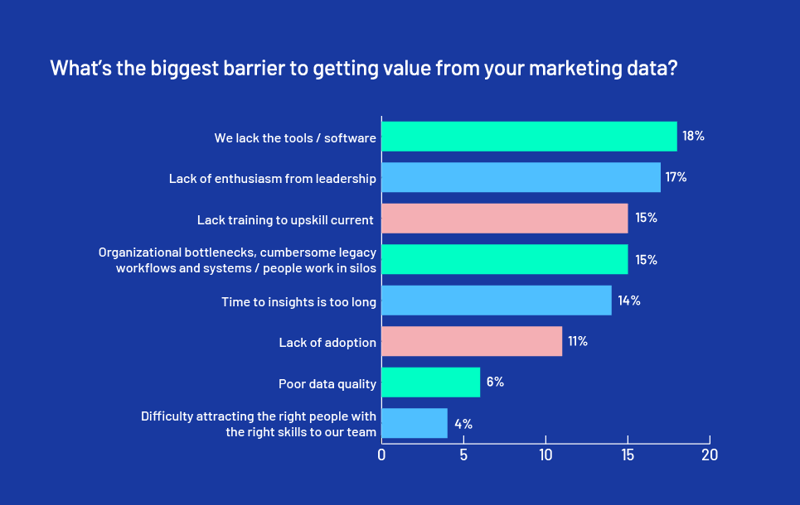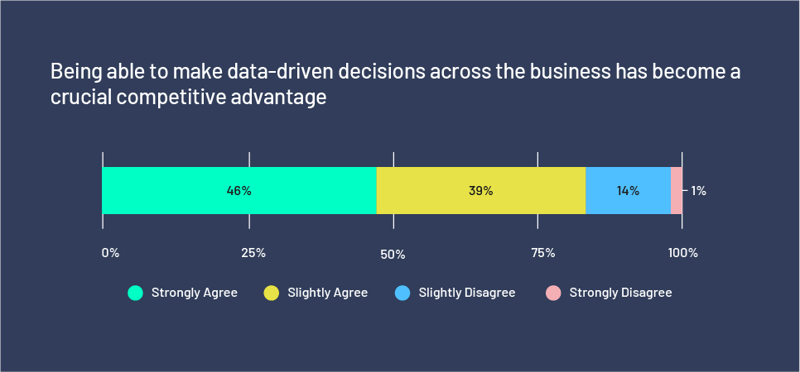In today's data-driven world, simply having the right technology isn’t enough to ensure success. It takes a combination of three essential elements: the right people, a data-driven culture, and the right technology. When businesses invest in these three cornerstones, they can significantly improve the analytical maturity of their marketing department and in turn the overall performance of their marketing efforts.
This blog will explain why these three cornerstones are so important to marketing success and how marketers can overcome some common challenges they might face along the way. But first, let's explore why data maturity is crucial and how it can help businesses weather economic storms and come out stronger.
Why is data maturity important?
Data maturity plays a vital role in an organization's resilience during times of recession. Research has shown a strong correlation between companies that prioritize data maturity and their ability to withstand economic shocks.
By focusing on building a data-driven culture, optimizing data operations, making strategic technology investments, and advocating for automation, organizations consistently achieve higher pre-tax earnings during economic crises.

It's tempting to prioritize short-term pressures and cost-cutting measures during a crisis. However, taking the long view and fueling compelling marketing efforts can help businesses not only weather the storm but also emerge stronger. Remaining resilient and competitive requires a steadfast commitment to data maturity.
So let’s take a look at what that actually means, and what challenges marketers might face along the way.
The 3 cornerstones of data maturity:
Cornerstone 1: Technology
Finding the right data stack has become increasingly essential for businesses in order to take advantage of the growing amount of data available to marketers, and gain the competitive edge. While integrating data automation tools with existing complex reporting processes can be challenging, the evidence is mounting that data tools offer competitive advantages that are well worth the investment.
Challenge: Lack of data tools
A recent survey of 300 CMOs showed that their most significant challenge in leveraging marketing data is a lack of data tools, affecting 18% of organizations.
Without the right tools to handle vast amounts of data from multiple platforms, teams can quickly become overwhelmed and struggle to make decisions that target audiences more effectively, and stretch budgets further.

To address this, CMOs should consider investing in data tools that streamline data management and reporting processes, allowing analysts to focus on extracting valuable insights.
“The ability to manage smart systems effectively is critical to producing the trustworthy, valuable insights marketers need to accurately measure ROI and make decisions.”
- Harriet Durnford Smith, CMO, Adverity
Cornerstone 2: People
Technology, however, is not a silver bullet and alone won’t ensure a successful data strategy. Expertise is needed to understand and operate data automation tools, which presents a challenge for organizations lacking data analysts or IT staff.

While 85% of CMOs recognize the competitive advantage of data-driven decision-making, a lack of data skills within the team inhibits investment in data automation tools.
“Many organizations are employing data scientists and then filling up their time with mundane work like manually pulling together data from different sources. Not only does this undermine data quality, but it also means that analysts aren't able to use the advanced skills they were hired for.”
-Adverity Marketing Analytics State of Play 2022
Challenge: The data skills talent gap
Currently, there is a shortage of marketing professionals with data skills, making it harder to hire new employees than to upskill the existing team. Research also revealed that more than a third of CMOs say retaining these sought-after data specialists is becoming increasingly difficult. To retain data talent and overcome the challenges posed by a lack of necessary data skills, companies must create an environment where data professionals can thrive.
This means investing in tools that will automate repetitive, time-consuming data integration tasks. At present, 49% of CMOs agree that the amount of manual reporting required is putting people off wanting to work in their marketing team. It also means fostering a safe culture that leaves room for data experiments to fail and be improved upon rather than pushing for positive optics at any cost, and ensuring employees have access to relevant training and development opportunities.
“You've got to create a safe culture where everyone is comfortable saying, ‘Yeah, it broke yesterday. And I was at the wheel when we drove the car into the wall,’”
Challenge: Lack of training to upskill employees
So, it’s becoming more difficult to hire and retain data specialists, and that means that unless you have a big budget for hiring or a cutting-edge strategy to retain top-tier data talent, then it’s time to consider upskilling. But upskilling existing employees poses its own challenges. In fact, the fourth most pressing challenge is a lack of training to upskill employees (15%).
At the moment, there’s a gap between the marketers (who have a much clearer picture of the marketing strategy), and the data-savvy analysts (who have access and understanding of all the data tools). In fact, many marketers aren’t currently aware of the data tools their team has access to and the benefits they can bring.
Google’s digital garage is only going to get you so far if you’re upskilling employees in silos. Analysts and marketers must work together to get the most from their marketing tech stack, and drive actionable results.
Cornerstone 3: Culture
Establishing an automated data workflow is crucial, but it's equally important to ensure that the data reaches the right people and drives informed decision-making. This is where data democratization comes into play.
Data democratization is the practice of enabling all employees, including those with lower data literacy levels, to access and gather accurate data about the business from a single source of truth, without external assistance. It ensures that workflows contribute to broader business objectives. To learn more about implementing data democratization, check out our step-by-step guide.
"You might have the greatest tech stack in the world feeding you business-changing forecasts on your ad spending and delivering real-time performance data, but if this isn’t translating to actions, then it’s useless."
Alexander Igelsböck, CEO, Adverity
Challenge: Lack of enthusiasm from the C-Suite
One of the main challenges within the culture cornerstone is the lack of support from the C-suite, with 17% of CMOs reporting this issue. A data-driven culture needs top-down support to be truly effective.
To overcome this challenge, marketers should frame data-driven solutions in terms of business-critical questions. Jeff Coleman, Leader of Digital Marketing Science at Carter’s, recommends framing data as a solution to get key stakeholders on board.
“Explain the problem, and how to solve the problem”, he says, “and then start to bring in how data is part of that solution.” You can read more of Jeff’s insights from his session from ICS MAX Georgia here.
Challenge: Legacy systems and bottlenecks
Cumbersome legacy workflows and the resulting silos and bottlenecks pose another challenge within the culture pillar, affecting 15% of organizations. While upending legacy workflows may seem daunting, the benefits of connecting data across teams and companies far outweigh the challenges.
It’s not always easy to take a step back and realize there’s an easier way, but the marketing world is fast approaching the point where it’s harder to hold on to legacy workflows than it is to reinvent them. Investing in connecting up data across your team and your company isn’t the leap of faith it once was and the benefits are fast becoming too valuable for competitive organizations to ignore.
Investing in tools that bridge gaps and democratize data can break down data silos and unlock valuable insights for competitive organizations.
Conclusion: The power of data automation
Data automation provides marketers and data analysts with significant benefits, including time savings, reduced errors, increased efficiency, and real-time insights. By embracing data automation, marketers can respond quickly to campaign opportunities, optimize budgets, and drive better ROI. While implementing data automation may pose challenges, the risks of delaying the adoption of data-driven practices are increasingly significant in today's competitive landscape.
In summary, building a data-driven team requires a strong foundation based on the three cornerstones of data maturity: the right people, a data-driven culture, and advanced technology. By investing in these pillars, businesses can become more resilient, gain a competitive edge, and capitalize on the power of data to drive success.










